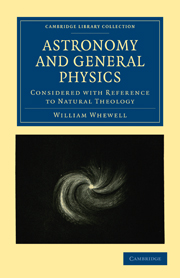Book contents
- Frontmatter
- NOTICE
- Contents
- INTRODUCTION
- BOOK I TERRESTRIAL ADAPTATIONS
- BOOK II COSMICAL ARRANGEMENTS
- CHAP. I The Structure of the Solar System
- CHAP. II The Circular Orbits of the Planets round the Sun
- CHAP. III The Stability of the Solar System
- CHAP. IV The Sun in the Centre
- CHAP. V The Satellites
- CHAP. VI The Stability of the Ocean
- CHAP. VII The Nebular Hypothesis
- CHAP. VIII The Existence of a Resisting Medium in the Solar System
- CHAP. IX Mechanical Laws
- CHAP. X The Law of Gravitation
- CHAP. XI The Laws of Motion
- CHAP. XII Friction
- BOOK III RELIGIOUS VIEWS
CHAP. III - The Stability of the Solar System
from BOOK II - COSMICAL ARRANGEMENTS
Published online by Cambridge University Press: 05 August 2011
- Frontmatter
- NOTICE
- Contents
- INTRODUCTION
- BOOK I TERRESTRIAL ADAPTATIONS
- BOOK II COSMICAL ARRANGEMENTS
- CHAP. I The Structure of the Solar System
- CHAP. II The Circular Orbits of the Planets round the Sun
- CHAP. III The Stability of the Solar System
- CHAP. IV The Sun in the Centre
- CHAP. V The Satellites
- CHAP. VI The Stability of the Ocean
- CHAP. VII The Nebular Hypothesis
- CHAP. VIII The Existence of a Resisting Medium in the Solar System
- CHAP. IX Mechanical Laws
- CHAP. X The Law of Gravitation
- CHAP. XI The Laws of Motion
- CHAP. XII Friction
- BOOK III RELIGIOUS VIEWS
Summary
There is a consequence resulting from the actual structure of the solar system, which has been brought to light by the investigations of mathematicians concerning the cause and laws of its motions, and which has an important bearing on our argument. It appears that the arrangement which at present obtains is precisely that which is necessary to secure the stability of the system. This point we must endeavour to explain.
If each planet were to revolve round the sun without being affected by the other planets, there would be a certain degree of regularity in its motion; and this regularity would continue for ever. But it appears, by the discovery of the law of universal gravitation, that the planets do not execute their movements in this insulated and independent manner. Each of them is acted on by the attraction of all the rest. The Earth is constantly drawn by Venus, by Mars, by Jupiter, bodies of various magnitudes, perpetually changing their distances and positions with regard to the earth; the Earth in return is perpetually drawing these bodies. What, in the course of time, will be the result of this mutual attraction?
All the planets are very small compared with the sun, and therefore the derangement which they produce in the motion of one of their number will be very small in the course of one revolution. But this gives us no security that the derangement may not become very large in the course of many revolutions.
- Type
- Chapter
- Information
- Publisher: Cambridge University PressPrint publication year: 2009First published in: 1833



